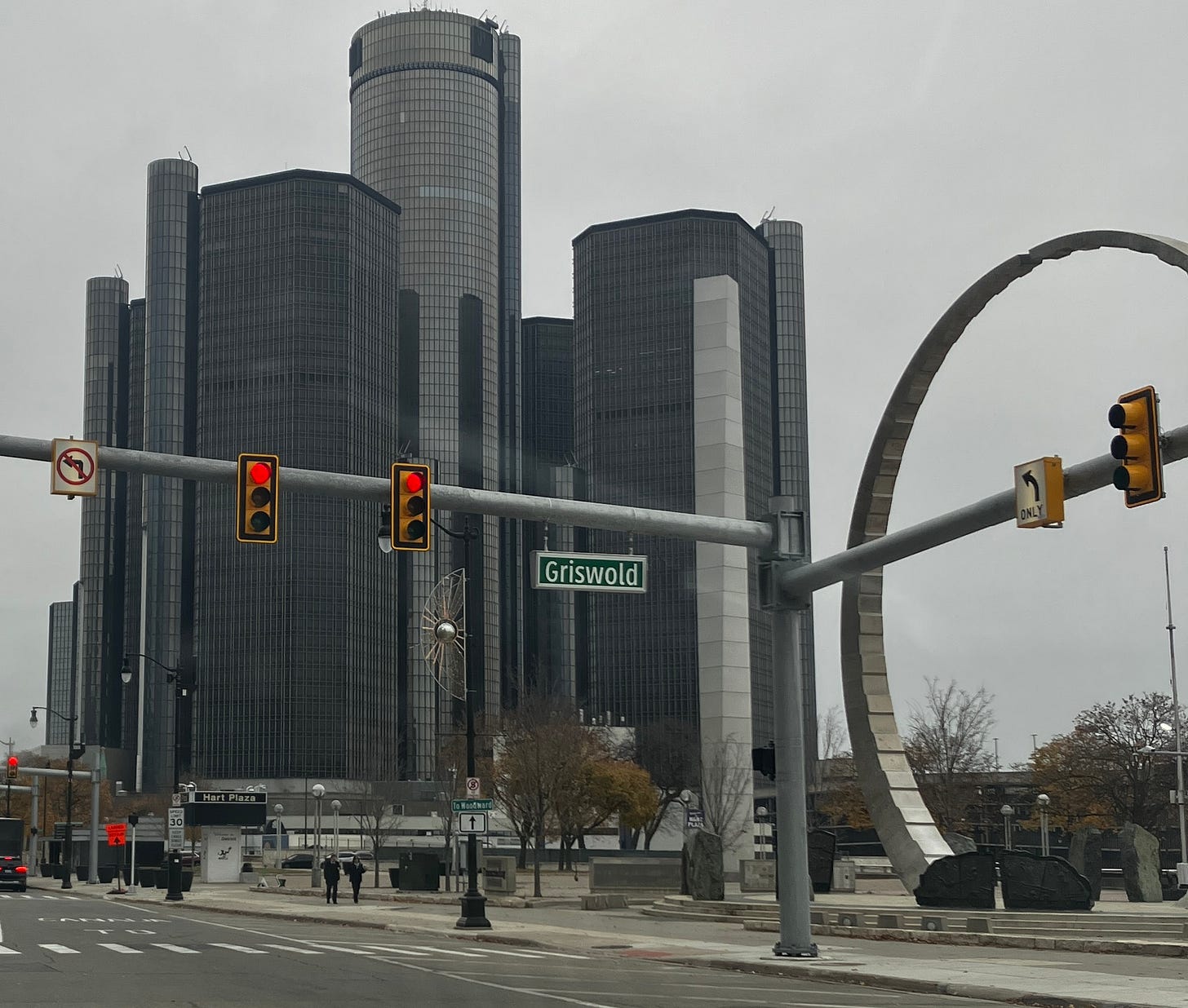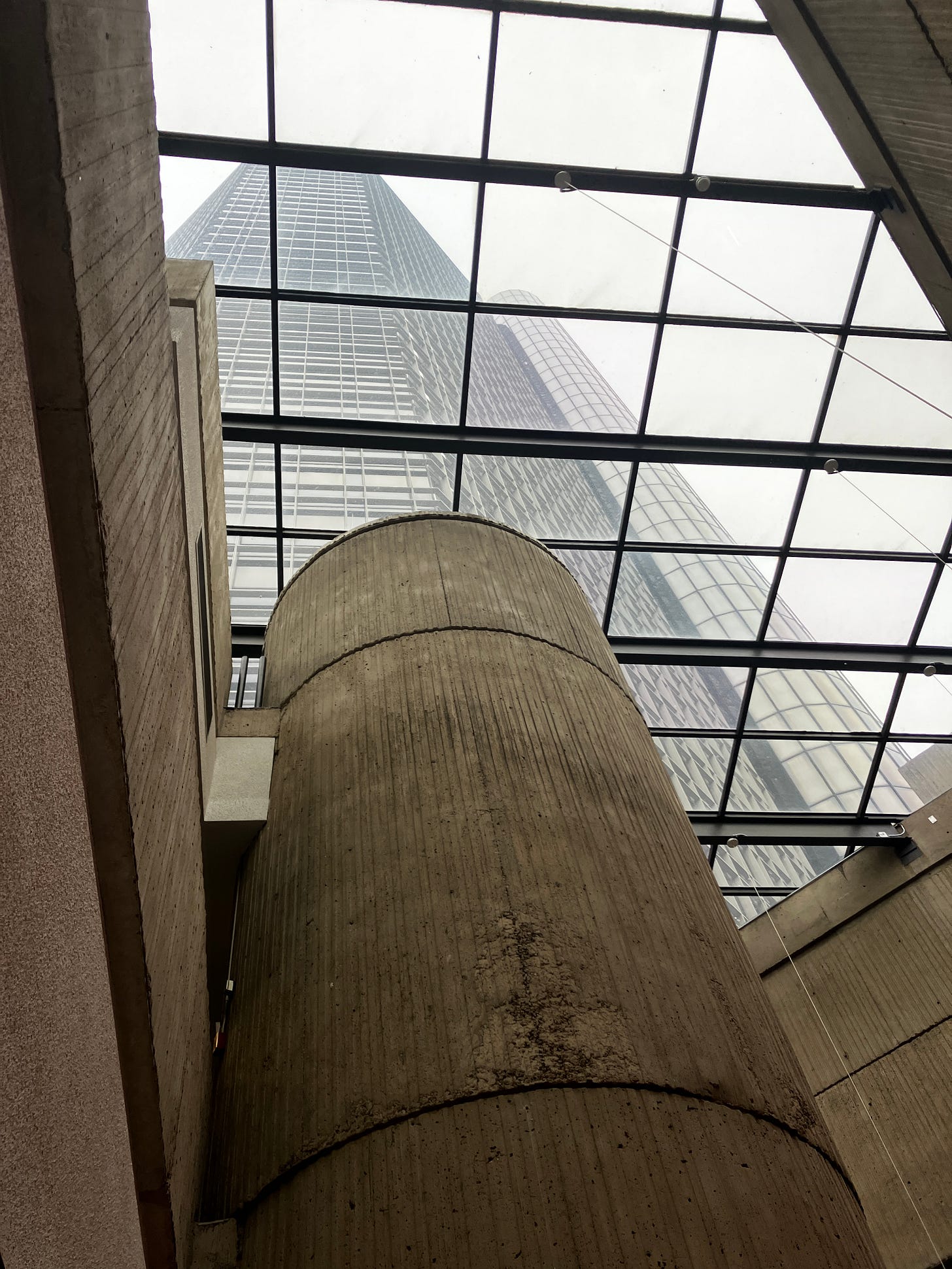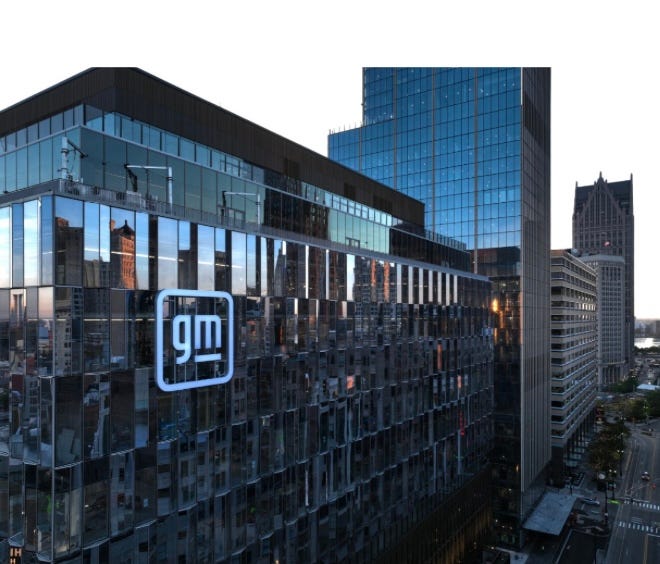My Last Time (Probably) In The Renaissance Center, And A New HQ For Ford
Two auto giants are moving their headquarters at the same time
Back in the late 20th century, the headquarters buildings of the Detroit automakers were as fixed as the constellations.
There was the General Motors Building on West Grand Boulevard. It sat in the New Center area, named in 1933 after a newspaper called the New Center News. (Use that in your next pub trivia game.)
The New Center was supposed to be a new center of commerce for Detroit, sitting about a 15 minute drive north of its traditional downtown business area. Construction of the GM Building was started by William Crapo Durant, aka Billy Durant, the mercurial founder of GM and co-founder of Chevrolet.
The building was finished after his ouster, but you can still see the letter D carved into stone on the facade of the building, now owned by the state of Michigan.
Beyond GM, there was Ford World Headquarters, or WHQ in auto slang. Nicknamed the Glass House, it was built by architects Skidmore, Owings and Merrill and opened in 1956, when its international style seemed au courant.
Chrysler operated out of the K.T. Keller Building in Highland Park, adjacent to Detroit, which dated back to 1928. Among the three, it was the most nondescript, with offices for executives like Lee Iacocca and Robert A. Lutz, after he, too, left Ford for Chrysler.
Finding new digs
By the 1990s, however, two of the companies decamped to what at the time were more modern surroundings. Chrysler left first for Auburn Hills, Mich., a newly emerging suburb north of Detroit. It built a 14-story headquarters tower whose atrium sported a pentastar, and a $600 million technical center that seemed to go on forever.
Not to be outdone, GM left its original building to head downtown. In 1996, Harry Pearce, who had served as GM’s chief lawyer and subsequently as its vice chairman, struck a deal to purchase the Renaissance Center, a symbol of the city’s attempt at a comeback, for a mere $75 million.
Ford, which had been one of the original RenCen tenants, stayed put in Dearborn. But the eviction of its staff from the RenCen by GM meant it had to put those people somewhere. It vamped by taking two mid-sized towers within sight of the Glass House, and by dispatching employees to various other places.
Now, in 2025, GM and Ford have almost simultaneously given up on the buildings where they’ve been rooted for decades, and their moves provide to change Detroit’s mental auto industry map.
A last visit to collect an honor
Last week, I was delighted to be honored by WJR-AM radio as part of the 2025 class of Women Who Lead. It is an illustrious group that includes women who run universities, hospitals, non-profits and companies. You can read the entire list here.
The honorees’ luncheon was held in Joe Muer’s, a venerable Detroit seafood restaurant on the RenCen’s first floor. That morning, I realized it was probably the last time I’d set foot in the glass covered landmark.
GM has begun the process of moving to the new Hudson’s Detroit tower, built by billionaire Dan Gilbert. It sits on the site of the J.L. Hudson department store about a 10-minute walk north on Woodward Avenue. Fans attending Detroit Tigers games have been able to watch the construction as the tower rose and in some cases, blocked their view of the RenCen.
In the course of leaving the RenCen, GM is evicting all its tenants, except for the Marriott Hotel, which eventually is supposed to be replaced by another property farther east on the Detroit Riverfront.
A souvenir snapshot
As we drove up Jefferson Avenue to the complex, I snapped the photo above that may have captured one of the last times the entire RenCen will be intact.
Two of its smaller towers are set to be torn down, and the future of the entire place is in doubt, depending on what GM and Gilbert’s company decide.
Readers of this newsletter known I’d be perfectly happy if the RenCen is demolished and its prime location used for a public purpose. There are already new paths and parks along the river, and planners can certainly come up with an attractive and appealing use for the site.
Inside the door, I looked up to see one of the trademarks of the RenCen: concrete. It is clearly a building that has seen better days, and concrete, as anyone familiar with construction knows, does not stay pristine for long. It absorbs dirt, odors and has to be cleaned regularly, a significant task in a skyscraper that is full of pillars.
I thought about all the visits I had paid to the RenCen through the years. I went to interview GM executives, who barely seemed to notice the spectacular view out the windows, and who often met with us in conference room with closed blinds and curtains.
I remembered getting lost multiple times, until I figured out which corridors to take to which escalators and then the right elevator to take me upstairs. I had a favorite parking spot where I could access a skybridge and speed things up.
As many people have remarked, the RenCen seemed like it was walled off from the rest of Detroit, sending a signal of look, but don’t approach.
There’s no wall around Hudson’s Detroit in fact, there is already retail on the first floor and famed restaurateur Danny Meyer, one of the friendliest people in hospitality, is taking charge of the food there.
Ford’s new digs
A different approach is going up in Dearborn. On Nov. 17, Ford inaugurated what it is calling its New World Headquarters (eventually, it probably will be known as WHQ, as well). It held an opening ceremony to which I was not invited, but which got ample coverage on local news.
The new WHQ is a four-story, 2.1 million square foot building that sits on the site of Ford’s old design center, across from The Henry Ford museum and Greenfield Village, where I’ve been going my entire life.
I attended an exhibit at the museum last summer, and looked across the street to the construction site. At the time, Ford only was talking about it as a development center for electric vehicles, and I remember thinking that it was way too big just for that purpose. I had an inkling then that it would become the company’s new center of operations.
In its press release, Ford says the building is supposed to “enable a more efficient future” for the carmaker. It was able to take its old street address — 1 American Road — with it from its previous building.
“This campus reflects our enduring belief in American innovation and American leadership,” chairman Bill Ford Jr. said. “Though Ford is a global company, it is — and will always be — an American company at its heart. … If you come looking for our home, you will still find us at 1 American Road.”
The building, shaped by three overlapping hexagons, will hold accommodate 4,000 employees when it’s completed in 2027, twice that of the Glass House.
Lavish declarations
I had to smile reading the company’s flourishing description. “Ford’s walkable campus….includes more than 12 acres of greenspace and walking paths, and see the building’s six interior courtyards, which add another 100,000 square feet of outdoor space for employee use.”
There is a 160,000-square-foot Gallery Hall dining area which features seven food stations, markets and coffee bars. (But, do they serve the macaroons that we used to smuggle out of the Glass House cafeteria?) All this for a company that, during Covid, told employees they could work from home indefinitely.
It reminded me of Chrysler’s own declarations when it opened the Tech Center in 1992. At the time, Iacocca said the 5.3 million square foot complex was the “finest automotive R&D facility in the world.”
Now, Chrysler is owned by Stellantis, its fourth overseer since then. For a while this decade, the tech center and the tower seemed like ghost towns, as Stellantis sorted through what it wanted to do with its American acquisition.
It contends that the CTC is vital to the company’s electric vehicle future, which of course has become murky, like everything around EVs in this White House.
Given that the other two companies are enjoying new digs, I wouldn’t be surprised if Stellantis takes its own leap to something that better fits its shrunken American footprint.
The companies’ movement goes to show that constellations aren’t fixed, and that our mental maps need to be regularly updated, just like apps on our phones.
Support Intersection with a paid subscription, or alternatively, Buy Me A Coffee.






